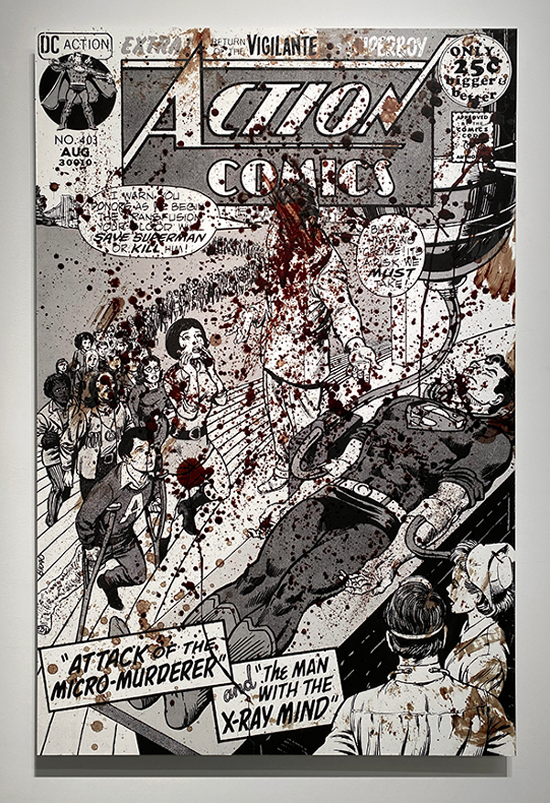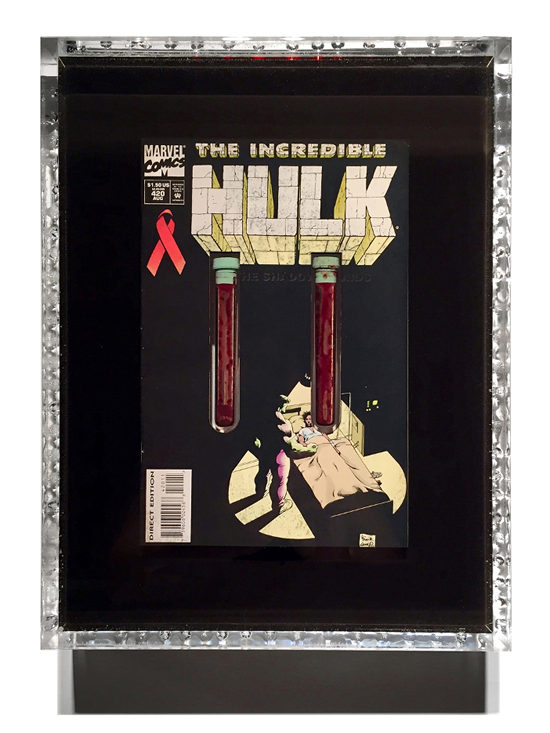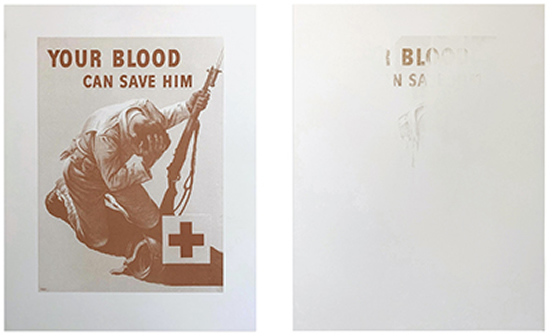
|
See “Can You Save Superman? II” exhibition by artist Jordan Eagles
in 2021
by Shannon Thomason

Jordan Eagles, "American Carnage 6/14-II," 2018, Blood of gay man on PrEP,
digital print, Dibond, 55 x 36 in.
December 17, 2020 - “Can You Save Superman? II,” an exhibition by artist Jordan Eagles that confronts the Federal Drug Administration’s blood donation policy against the LGBTQ community, will be on exhibition at the University of Alabama at Birmingham in 2021.
Eagles’ ongoing cycle of art and activism addresses the stigma of “queer” blood and challenges these policies.
“LGBTQ+ rights, health policies, body autonomy and saving lives are all on the line, and the implications at this moment in time are severe,” Eagles said. “Even during a global pandemic, and with massive blood shortages, the FDA continues discriminatory policies for donating blood and plasma based on sexual orientation.”
“Can You Save Superman? II” is guest curated by Andy Warhol scholar Eric Shiner. It is presented by UAB’s Abroms-Engel Institute for the Visual Arts and travels to AEIVA from the Leslie-Lohman Museum of Art in New York City in a new iteration as a hybrid exhibition.
The exhibition will open Jan. 18, 2021, and be on view through World Blood Donor Day on June 14, at AEIVA, 1221 10th Ave. South. The works will be physically in the AEIVA lobby and simultaneously online in a virtual exhibition. View a virtual component online at www.CanYouSaveSuperman.com. For more information, visit uab.edu/aeiva.
For this new series, Eagles appropriates vintage comic books whose iconic characters — from Superman to The Hulk — are situated within storylines that revolve around blood donation, health care, HIV/AIDS, racism and stigma. Eagles pairs the comics with blood donated from members of the LGBTQ+ community to reframe the narratives, providing new ways of addressing the current crises.
The exhibition is anchored by a 1971 Action Comics, titled “Attack of the Micro-Murderer,” in which Superman is infected by a futuristic super-virus. Superman calls on the Metropolis citizens to donate blood for a mass transfusion to save his life. He is depicted lying lifeless on a gurney with tubes in his arms and an infinite line of people willing to share their blood. The image is resonant of media depictions in the aftermaths of horrific tragedies, when communities come together — and heal — through selfless acts of blood donation. The comic cover is enlarged and manipulated with the donated blood of a gay man on PrEP — pre-exposure prophylaxis is a daily pill proved to be 99 percent effective in preventing HIV transmission — splashed onto the image. The result presents a stark contrast: In 1971, a gay man could help save Superman; but in 2021, despite advances in science, treatment and HIV prevention, he cannot.
“Discriminatory and unnecessary deferral periods in place today against gay and bisexual men prevent us from donating blood and helping to save lives in our communities,” Eagles said.

"Untitled (HULK/AIDS)," 2018, Original "The Incredible Hulk, In The Shadow of AIDS (1994)," blood of gay man on PrEP, blood from HIV+ undetectable donor, collection tubes, residual blood, plexiglass, UV resin, 15 x 12 x 3 in.
The series also features sculptural works, pairing original vintage comic books that have been laser-cut to hold medical tubes used for collecting the blood of an HIV-positive, long-term survivor with an undetectable viral load, and an individual on PrEP. In the comic “The Incredible Hulk, In the Shadow of AIDS” (1994), the Hulk’s friend, Jim — an African American man dying of AIDS — wants the Hulk to transfuse his radioactive blood so it can save him. Hulk will not do it, and his friend dies in the end. In “The New Guardians” (1988), a villain named Hemogoblin is introduced. Hemogoblin is a genetically engineered vampire with AIDS, created by white supremacists to attack, infect and kill minorities with AIDS. Eagles’ resulting artworks highlight how fear of transmission and HIV/AIDS stigma can be equated to imminent death even though science has evolved over the decades, as we still continue to fight the epidemic.
The virtual component of the exhibition on www.CanYouSaveSuperman.com includes striking details, full-color photography, the preserved original comic book, and a haunting, first-person essay by Shiner on Superman, the Black Power movement, the AIDS crisis, blood equality and COVID-19, contextualizing and activating the viewing experience.
AEIVA will also display two prints from its permanent collection, from Eagles’ series “Our Blood Can Save Them.” A 1943 WW II poster image was screen-printed, using a pint of donated blood from a transgender, pansexual, active United States military service member. Every drop of his blood was used, and as it ran out, the image gradually fades. For Eagles, this work focuses on the erasing of communities through discrimination and the history of Dr. Charles R. Drew, a prominent Black surgeon, doctor and medical researcher, who developed blood storage techniques as part of a successful program to collect blood and export the plasma to the Allied forces in Europe during WW II; Drew eventually resigned his position in protest of racial segregation of blood.
This exhibition is presented in partnership with the Leslie-Lohman Museum of Art, Visual AIDS, GMHC, Blood Equality, New York City AIDS Memorial, The LGBT Community Center, University Blood Initiative and The New York City HIV Planning Group.

"Our Blood Can Save Them," 2018, screen-printed blood of a transgender, pansexual, active U.S. Service Member on paper, 26 x 20 in. each. Collection of AEIVA.
This is Eagles’ second solo exhibition with AEIVA. The first was in 2017 for his exhibition “Blood Equality,” which corresponded with the display of “Blood Mirror” at the Birmingham Civil Rights Institute. Eagles is a New York-based artist who has been exploring the aesthetics and ethics of blood as an artistic medium since the late 1990s. Eagles’ works made with donated blood from the LGBTQI+ community advocate for fair blood donation policy, anti-stigma and equality. His works created with animal blood from slaughterhouses address life cycle, corporeality, spirituality and regeneration. Eagles’ exhibitions, installations and public programs include The Andy Warhol Museum in Pittsburgh, Pennsylvania, Museum of the City of New York, High Line in New York, Science Gallery London and Melbourne, Hammer Museum in Los Angeles, and American University Museum in Washington, D.C. Eagles collaborated with the NYC Department of Health and Mental Hygiene on NYC Blood Sure and is a co-founder of Blood Equality.
Shiner is executive director of Pioneer Works in Red Hook, Brooklyn, New York. From 2011-2016, he was the director of The Andy Warhol Museum in Pittsburgh, after serving as the Milton Fine Curator of Art at the museum beginning in 2008. He was most recently the artistic director at White Cube Gallery in New York; prior to that, he was senior vice president of Contemporary Art at Sotheby’s. Throughout these experiences, Shiner has demonstrated his commitment to lead in ways that promote diversity, inclusion and social justice. He is president of the board of Visual AIDS and also serves on the board of City of Asylum in Pittsburgh.
###
MEDIA CONTACT:
Shannon Thomason | Public Relations Specialist
University Relations | Public Relations
UAB | The University of Alabama at Birmingham
AB 660 | 701 20th St. South. | Birmingham, AL 35233
She / her / hers
P: 205.975.8858 | M: 205.504.0311
thomason@uab.edu
Source: https://www.uab.edu/news/arts/item/11765-see-can-you-save-superman-ii-exhibition-by-artist-jordan-eagles-in-2021
"Reproduced with permission - The University of Alabama at Birmingham"
The University of Alabama at Birmingham
For more HIV and AIDS News visit...
Positively Positive - Living with HIV/AIDS:
HIV/AIDS News
|